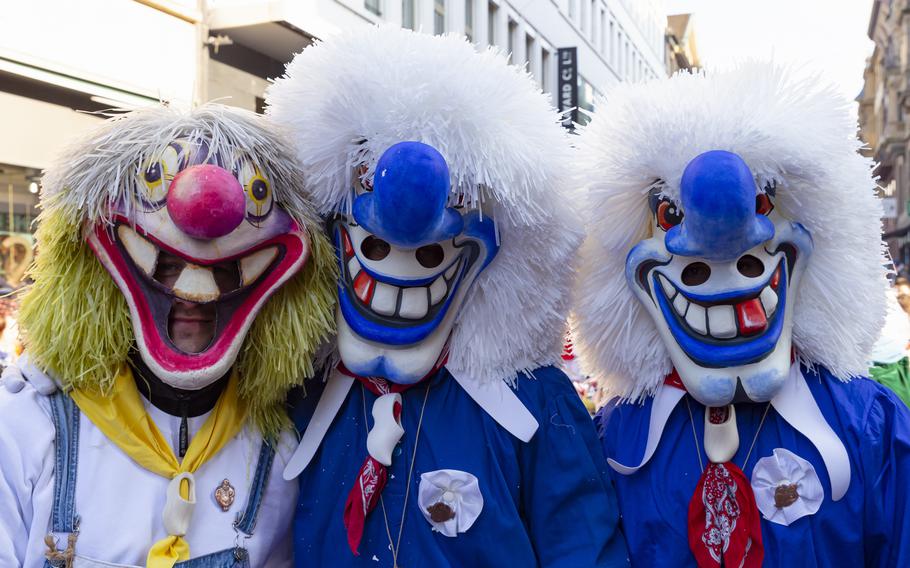
Costumed entertainers take to the streets during Fasnacht in Basel, Switzerland, in 2022. (iStock)
Carnival, Karnevale, Fasching, Fasnet ... the tradition of celebrating wildly before entering into the somber pre-Easter season of Lent is customary throughout much of Europe. These end-of-winter festivities are nothing new; in fact, many of the rituals carried out are thought to be pagan in origin and pre-date Christianity. Carnival rites are so important to some cultures that the time and space they occupy is referred to as the year’s “fifth season.” For those not brought up within their traditions, many communities’ carnival practices can be mystifying. Despite that, a handful of them are so unique in their very nature that they would be worth bearing witness to, at least once in a lifetime.
Germany’s Black Forest region
In the heart of Germany’s Black Forest region lies the town of Schramberg, a hiker’s paradise famed for its Fasnet celebrations. On carnival Sunday, the “Hanselsprung” sees costumed marchers, many wearing hand-carved wooden masks that have been handed down through generations, jump and carry out various antics to the sounds of bells and music. The action unfolds from 2:30 p.m. on Feb. 19. The second spectacle is the “Da-Bach-na-Fahrt” boat race, in which the town’s bravest souls take to the waters of the brook that flows through town in small watercraft decked out like floats. Not all 80 riders in 40 boats will make it to the finish line without a dunk in the icy waters. The race, which begins at 1 p.m. on Feb. 20, is followed by another parade through the heart of town. Online: tinyurl.com/munmsm5b
Binche, Belgium
The town of Binche, located just a few miles east of Mons, plays host to one Europe’s oldest surviving street carnivals. The merriment is on full display come Shrove Sunday, when various masked revelers are joined by Mam’selles, men dressed in extravagant female attire (from 4 p.m. on Feb. 19). On Shrove Tuesday, the characters known as Gilles enter the scene, unmistakable in their costumes of red, yellow and black, ostrich-feather hats, wooden clogs and bells, and most peculiarly, wax masks adorned with small round spectacles. In the company of harlequins, dancers and other costumed characters, they march through town to the sound of brass bands and drumbeats. Events culminate with the dance of the Gilles at the Grand Place as fireworks burst overhead. (Parade begins at 3 p.m.; fireworks at 9:30 p.m. Feb. 21). Online: tinyurl.com/3t963437
Acireale, Sicily
The town of Acireale in Sicily is considered one of the carnival capitals of Italy. Just a short hop from Catania, between Mount Etna and the sea, the baroque beauty of a town stages a carnival best known for its parade featuring elaborate, papier-mâché floats, many decorated with geraniums and other live blossoms. Other floats mock politicians, TV and movie stars and other celebrities. Some of the displays are crafted from locally-grown lemons and oranges, adding a sweet scent to the air. Sophisticated lighting systems make viewing the floats by night a special experience. Bands, majorettes, folklore groups, dancers and other masked performers complete the scene.
Visitors have several chances to take part in festivities, with something slightly different on offer each day, including concerts, parades and general merriment. Carnival dates in 2023 include Feb. 4-5 and Feb. 11-21. The biggest parades take place from 3 p.m. Feb. 19 and from 10 a.m. Feb. 21. For most dates, tickets are required; these go for 7 euros when purchased online or can be purchased at booths set up along the parade route. Children under 120 cm enter free of charge. Online: carnevaleacireale.eu
Basel, Switzerland
In contrast to the above-named celebrations, Basel’s Fasnacht play outs one week later, starting on the Monday following Ash Wednesday and continuing for three days straight. The action kicks off at 4 a.m. on Feb. 27 with the so-called Morgestraich. The city lights are switched off and the eerie atmosphere of dark and cold becomes all the stranger as the faint sound of drums and piccolos starts to echo through the streets. Costumed musical groups known as cliques begin to emerge from all corners, each accompanied by a brightly burning, lantern painted in keeping with a theme known as a “sujet.” The cliques ply the streets until dawn, when marchers and viewers alike head into the bars and restaurants to fortify themselves, likely on the most traditional of dishes including a flour-based soup or cheese or onion cakes.
From 1:30 p.m., the crowds return in force to witness the large street parade referred to as the Cortège. This consists of elaborate floats, horse-drawn carriages, and groups playing “Gugge,” a type of music played on brass instruments, pipes and drums at high volume and often intentionally off-key. The Cortège is staged once again at 1:30 p.m. Wednesday, March 1. On Tuesday night, the Gugge music groups perform throughout town, including on stages in Basel’s main squares. On Monday and Wednesday nights, “Schnitzelbank” groups sing witty verses in the local dialect; outsiders may enjoy but won’t get the joke. Attendees should be sure to purchase a Blaggedde, a badge whose purchase helps defray the cost of staging the festivities. Online: basel.com/en/events/carnival